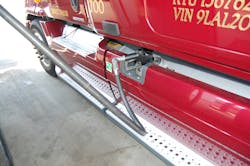Price spike continues for diesel and gasoline
Diesel and gasoline prices continued to rise this week, jumping 9.5 cents and 18.1 cents per gallon, respectively, compared to the week of January 28, according to data tracked by the Energy Information Administration (EIA).
The agency added that retail pump prices for both fuels are up over 12 cents and 22 cents per gallon, respectively, over the last two weeks.
The EIA reported that the U.S. average for diesel now rests at $4.022 per gallon, some 16.6 cents per gallon higher compared to the same week in 2012. Prices are up in every region of the U.S. the agency added, with California ($4.242 per gallon), New England ($4.232), the Central Atlantic ($4.165) and lower Atlantic ($4.008) home to the highest prices for the fuel in the nation.
Gasoline reached a U.S. average of $3.538 per gallon this week, EIA said; 5.6 cents per gallon higher compared to the same week in 2012. The agency again stated that gasoline prices are up in every region of the U.S., with the West Coast ($3.936 per gallon), New England ($3.682), and the Central Atlantic ($3.665) home to the highest retail pump prices in the country.
The EIA also noted that gasoline expenditures in 2012 for the average U.S. household reached $2,912, or just under 4% of income before taxes – the highest estimated percentage of household income spent on gasoline in nearly three decades, with the exception of 2008, when the average household spent a similar amount.
Although overall gasoline consumption has decreased in recent years, the agency said, that rise in average gasoline prices has led to higher overall household gasoline expenditures.
Still, those expenditures as a percentage of overall household income are still low when compared to the early 1980s, when the estimated portion of household income spent on gasoline surpassed 5%. That’s largely because, even though travel per household is up significantly since the early 1980s, vehicle fuel efficiency is also significantly improved, thus reducing the amount of gasoline used per mile, according to the agency.
Indeed, efficiency gains have accelerated in recent years such that total U.S. gasoline consumption fell in 2011 to 134.2 billion gallons – its lowest level since 2001. Yet, at the same time, EIA's average city retail gasoline price rose 26.1% in 2011, and another 3.3% in 2012, when it reached $3.70 per gallon, meaning that higher prices in 2011 and 2012 outweighed the effect of reduced consumption.
The fiscal impact of that fuel increase on U.S. households is heavy, EIA noted in its report, as that 26.1% yearly increase back in 2011 for avergae city retail gas prices was six times greater than the 3.4% rise in nominal household income, while that 3.3% estimated gasoline price rise in 2012 outpaced the 2.9% estimated increase in household income.
About the Author
Sean Kilcarr
Editor in Chief
Sean Kilcarr is a former longtime FleetOwner senior editor who wrote for the publication from 2000 to 2018. He served as editor-in-chief from 2017 to 2018.
